18 Best Throwing Knives in 2022 (Reviews and Buying Guide)
- United Cutlery Kunai Throwers (Editor’s Choice)
- Perfect Point Knives (Best Value)
- Perfect Point Balanced Series.
- Smith and Wesson Bullseye Set.
- SOG Clip Point Throwing Knives.
- Magnum Bailey Bo-Kri Ziel Set (Best Overall)
- Magnum Bailey Mini Bo-Kri Knife Set.
Increase your skills with the blade and know how to properly use knives for self-defense. Learn basic tips in this article!
RELATED: Machete: A Beginner’s Guide
Contents
1
Knives for Self-Defense | Your Ultimate Guide
1.1
Defending Yourself with an Edged Weapon
1.2
Experience with Knives
1.3
Folding Knives or Fixed Blade Knives for Self-Defense
1.4
How to Grip Knives for Self-Defense
1.5
Think About Your Range
1.6
Attack with Eight Angles
1.7
Defend Against the Eight Angles of Attack
1.8
The Knife Alphabet
1.9
Practice with Feedback
1.10
Practice with a Partner
1.11
Bottom Line
Knives for Self-Defense | Your Ultimate Guide
Defending Yourself with an Edged Weapon
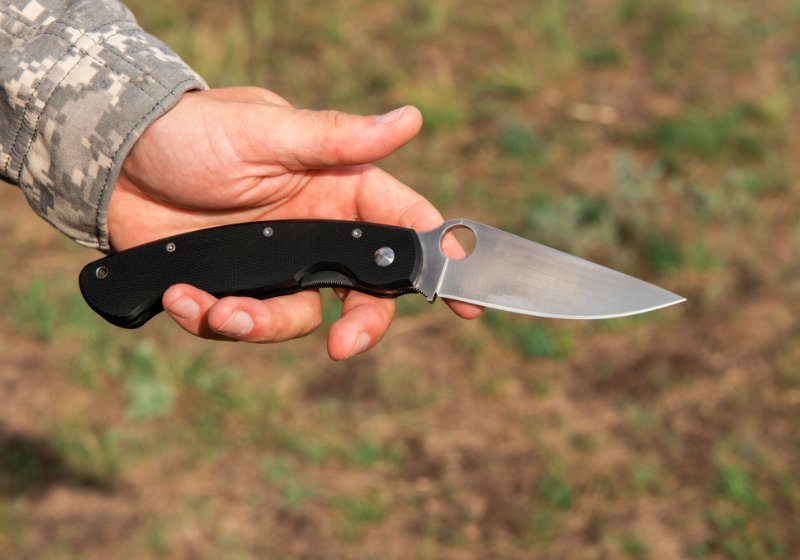
What do you think about using knives for self-defense? There are a lot of talks these days about the importance of not only being able to use a knife offensively but also having the ability to defend yourself with the blade.
Even many of the traditional martial arts are implementing an edged weapon component to their curriculum.
These days, all you need to do is turn on the news and you will see why a knife used in self-defense has become a precedence.
Criminals and terrorists are not only attacking the general public with an edged weapon. They are also targeting law enforcement with machete’s as well as other blades.
Experience with Knives

I was first exposed to various methods of knife training in the United States Marine Corps. We practiced with bayonets as well as our Kabar TDI law enforcement knife.
These were two of the blades that were standard issues and always out with us on the field. We heard many war stories from our instructors about the value of being proficient with an edged weapon.
Not only was it valid in trench warfare during World War I and II, but it has also been utilized by modern-day special forces fighting terrorism.
Once my active duty tour in the Marines was over, I continued my education on utilizing knives for self-defense. My focus was on FMA (Filipino Martial Arts) and other methods coming out of Eastern Europe.
Pulling movement patterns from both systems allowed me to gain a deeper understanding of how and when to deploy a blade during a combative situation.
There are many similarities to any good knife fighting system. Finding one you will stick to and practice often is the advice I give anyone who is beginning their training.
Please keep in mind there are no winners when it comes to most knife confrontations. Hollywood and even YouTube martial artists demonstrate applications that look amazing on video.
Although in real life, things are much messier and devastating than what most people realize is the truth. One of my teachers explained it to me this way:
“In most knife fights there are two outcomes, one fighter goes to the hospital while the other goes to the morgue.”
Folding Knives or Fixed Blade Knives for Self-Defense
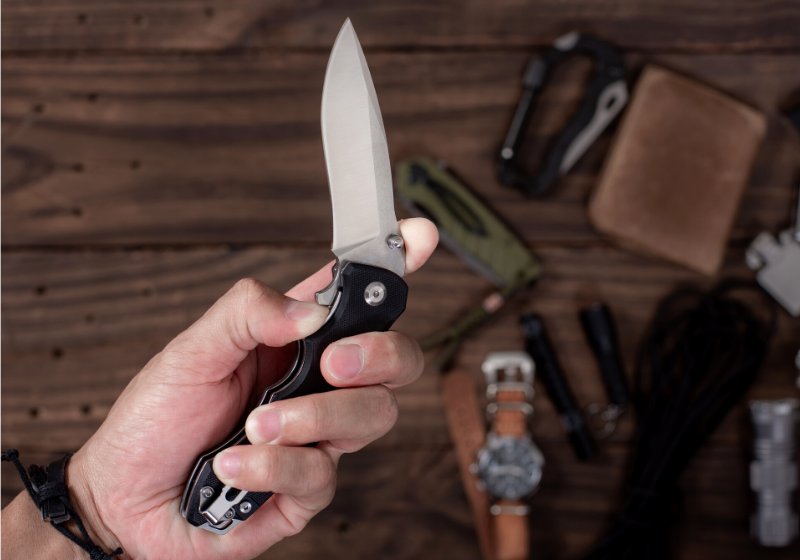
Just like most things in life, we all have different preferences and needs when it comes to the type of blade we choose to carry.
We have those who prefer tactical folding knives they can easily conceal in their pocket. There are others that feel the only true fighting knife is one that features a fixed blade.
The arguments on both sides are usually quite valid. However, there are laws and regulations, depending on your location, that will limit your choices to either one or the other.
I am currently based in New Jersey. Here, I am allowed to carry a folder as long as they meet certain specifications.
If I were to get in my car and drive just 40 minutes away to New York City, my folding knife will be illegal, but a fixed blade will be fine to carry.
My point here is we may not be able to carry our preferred blade, so it is always best to continually train with both types of knives.
How to Grip Knives for Self-Defense
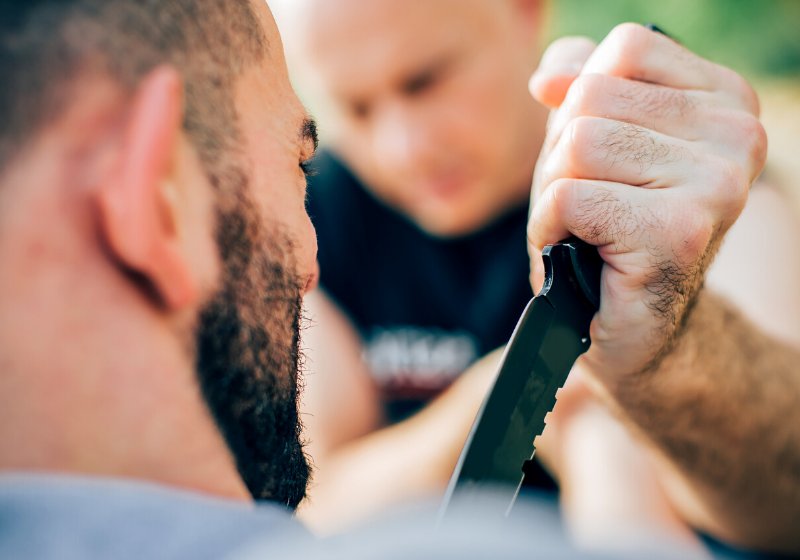
There are two main grips when it comes to the knife. There is the forward grip and the reverse grip. With the forward grip, the knife is usually tip-up. With the reverse grip, the opposite occurs and the tip is down.
There are different schools of thought as to which grip is best. It is true, we may have a preferred grip for wielding a knife but in a self-defense situation, that choice may not be available.
In an ideal scenario, you will be able to deploy your blade in your preferred grip. However, when SHTF during a combative encounter, your ideal grip may not be an option.
In a struggle, a blade may end up on the ground. When you retrieve that blade, it may be in either a reverse or forward grip. Knowing we cannot always get to our ideal grip, it is imperative you train with both positions in mind.
RELATED: 7 Self-Defense Video Techniques You Need To Know
Think About Your Range
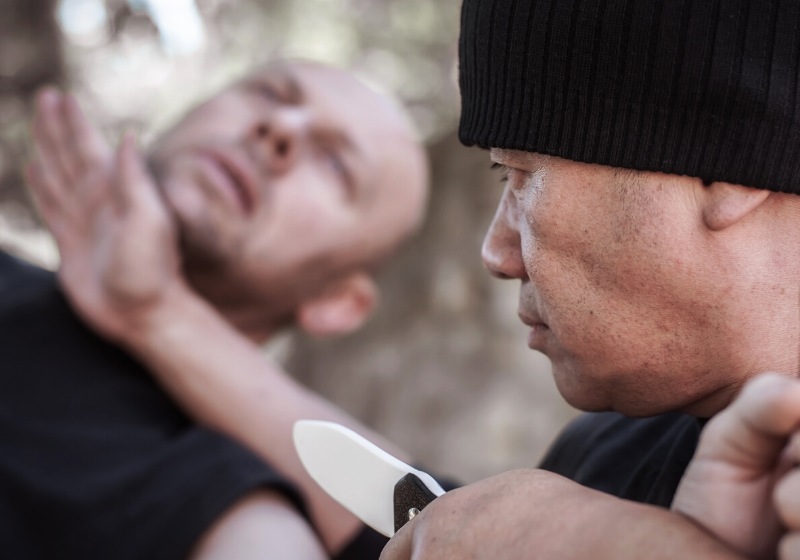
There are four main ranges when it comes to combative applications with the knife. The varied ranges are:
- Close Range – Within this range, you can elbow, knee, and headbutt your attacker.
- Mid Range – At mid-range, your empty hand can touch your opponent during an encounter when fully extended.
- Long Range – In the long-range, your empty hand is unable to touch your opponent when extended.
- Floor or Wall – This last range comes into effect once one plane of motion is removed. This occurs when up against a wall or on the floor.
The way we attack and defend against the knife has a lot to do with the range we are in.
As an example, when I am in the mid-range, I will need to use my empty hand to “check” my opponent’s strike. If I do not, I will get cut during their follow-through with the knife because of our short distance from each other.
If we are in long-range, there is no need to use my empty hand to check because my opponent will be too far from me to actually cause damage to my vitals.
Attack with Eight Angles
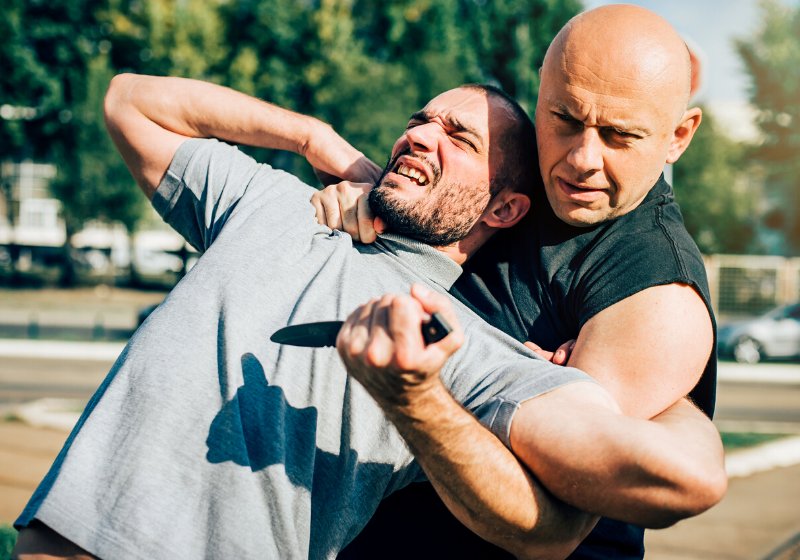
When it comes to teaching offensive movement with a knife, there needs to be a certain language spoken by the teacher and the student.
Instead of using complicated language to convey a movement, we use angles numbered from one to eight. Some teachers choose to utilize more angles, while other instructors opt for less.
Neither option is superior to each other, and it is completely up to the teacher’s discretion. If we were to use our neckline as an example, a knife strike coming diagonally from the right will be called an angle one.
A backhand coming to the right side of the neck on a diagonal will be an angle of two.
Utilizing a simple number system not only simplifies the learning process, but it allows much less processing time to speed up their movements.
Defend Against the Eight Angles of Attack

In order to try and bode well for an attack, we need to implement a defensive strategy. I do believe that offense is your best defense in a knife encounter.
As we discussed earlier, the range you are operating in has a lot to do with your approach to defending against an attack.
If I am in mid and close range, the most popular distances when it comes to knife fights, I need to use my checking hand to stop the assailant’s momentum.
If my opponent were to throw an angle one, while in mid-range, I may be able to cut his arm by throwing my own angle one. Even if I slice their arms open, the momentum of their strike will still continue towards my neck.
If I do not use my empty hand to check or nullify his momentum, I will lose the battle. Each angle has its own counter to defend against it.
Nothing is ever foolproof, but what we are trying to do is increase our chances of getting out alive and going home to our families. The more we practice from these angles, the better we will fair in this unfortunate situation.
The Knife Alphabet
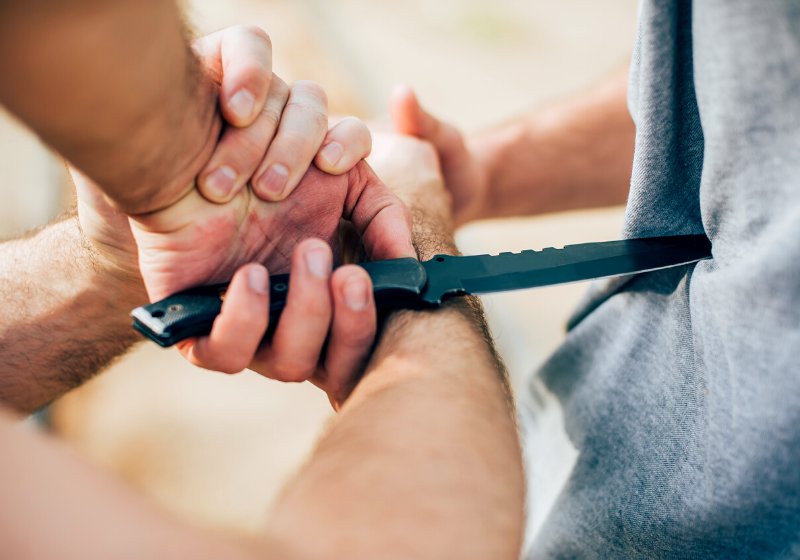
One way to develop good attributes with the knife is to mentally write out the alphabet utilizing your knife. Think about your opponent being directly in front of you as you trace the alphabet on his body.
Think of the tip of your knife as a ballpoint pen. You can then trace the letters in the air as you go through the whole alphabet.
Some of the patterns may feel a bit awkward, but it gives you a good reference point on which movements or angles feel the most comfortable for you. You can use both a forward and reverse grip for this exercise.
Once you feel proficient in tracing the letters of the alphabet in a static position, begin moving your feet around as you continue your practice.
Tying your breath to the tracing of the alphabet and the movement of your feet will allow you to flow in an uninterrupted movement. This takes continual and steady practice.
If you devote the time, the dance begins to become a natural part of you.
Practice with Feedback
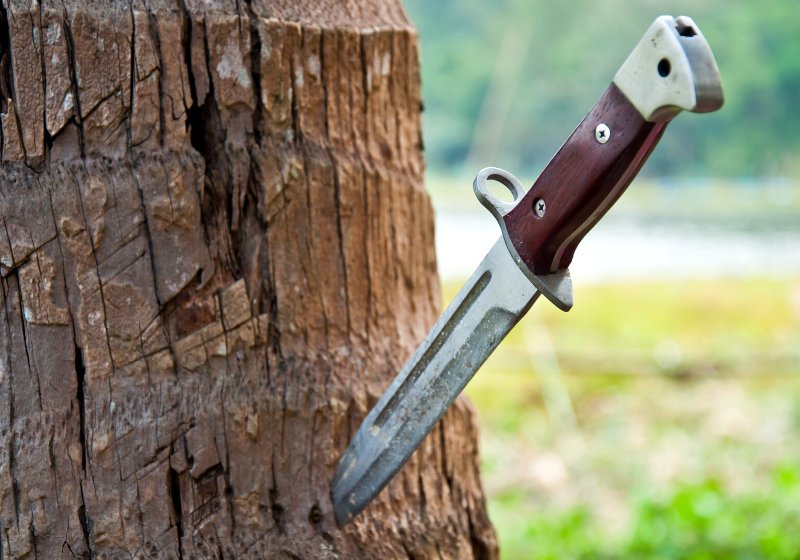
Free-flowing with your knife while only cutting through the air is a valuable practice. Once you feel comfortable with the dance, it is important to get feedback from the angles you throw.
In order to achieve this with a solo practice, use a tree or heavy bag to throw your eight angles at. You will quickly notice you are getting completely different feedback than you were when you were just throwing your angles in the air.
During a self-defense application, you will have to actually, strike a target. The way your knife will react to that strike is something you need to learn to control.
Devoting plenty of time to practicing your angles, while receiving feedback, is imperative if you hope to bode well for the battle.
Practice with a Partner
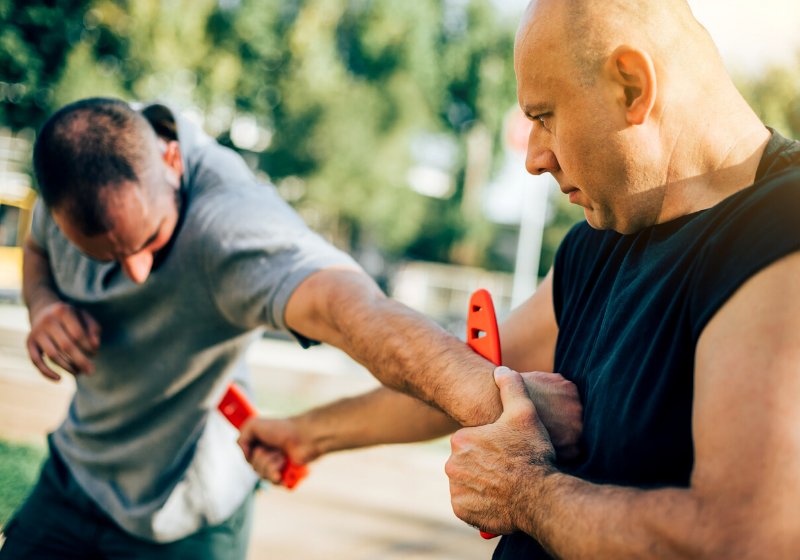
Practicing your angles with a partner is one of the best knife defense methods for developing your skills.
You will not only be getting direct feedback from a moving target, but you will also work both offensive and defensive applications of the knife. It will be a rare moment if an attacker remains in a static position during an attack.
Being able to move with him or her is crucial to utilizing knives for self-defense. Just like most skill-building endeavors, adding a partner makes things a bit more fun.
The motivation level tends to go up, and you also have each other as motivation for those days you do not feel like getting off the couch.
The more time you invest in training with your edged weapons, the more viable the blade becomes in real-world scenarios.
Bottom Line
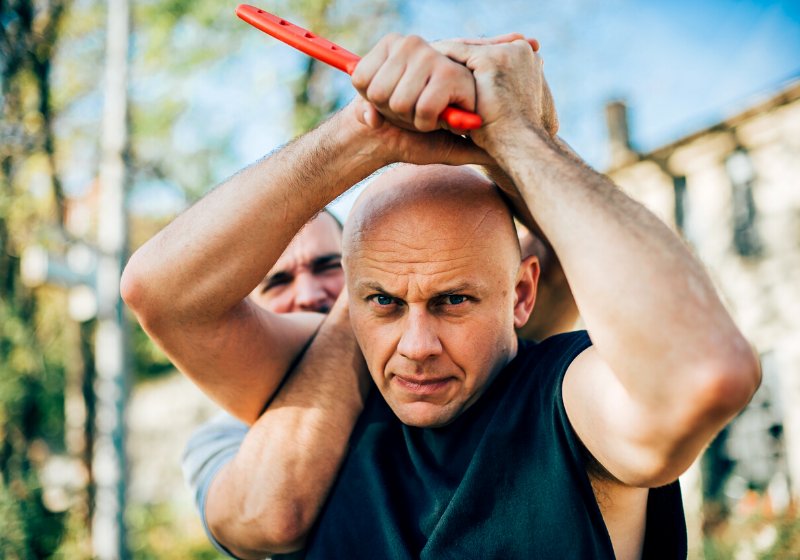
I see many people carrying knives for self-defense. Unfortunately for them, the time devoted to training is usually, minimal, at best.
I tell newer students it is best to leave the knife at home if they choose not to practice with it. The knife has to be an extension of your natural movement.
When it is not, it is more of a liability than an asset to you. The “bad guys” are out there training to be malicious. If you are not well versed with your knife, they can easily disarm you and use your own blade to cause your harm.
Watch this video of Coach Helder using a blade for self-defense:
As I mentioned earlier, there is rarely a good outcome when it comes to a knife encounter. We need to train to give ourselves a better chance to get home safely.
The world is getting a bit uglier each day. We need to prepare to not only keep ourselves safe but also to protect our loved ones. Train with knives for self-defense as if your life depends on it because someday, it just might!
Tell us your own knowledge and experience with knives for self-defense. Share your thoughts in the comments section below!
Questions about best throwing knives for self-defense
Can you use throwing knives for self defense?
Balance is the key for a successful throw. The question, though, is whether throwing a knife is a good idea for self-defense… The moment that knife leaves your fingers, you’ve lost your weapon. Regardless of whether you hit your target or not, the knife is lost to you until or unless you can recover it later.
Are throwing knives good weapons?
A throwing knife can be a deadly weapon in the hands of a skilled warrior, but a single blade means that a thrown knife will likely miss more often than it hits.
Can you walk around with throwing knives?
It’s legal to carry it in plain sight. If your throwing knives are longer than two or three inches, it might be illegal to carry them as concealed throwing knives. But if your throwing knives are small, you might be able to get away with carrying them as pocket throwing knives.
Details about knives bag
Junyuan Bags | Professional Bag Manufacturer
Ten articles before and after
Using Concealed Carry Purse: What You Need To Know | AGA| Professional Bag Manufacturer
5 Best Handgun For Beginners And First-Time Gun Owners | AGA| Professional Bag Manufacturer
Should You Buy An Air Gun Now? | Junyuan Bags Blog| Professional Bag Manufacturer
Women Self-Defense Weapons | 7 Useful Self-Defense Weapons For Women| Professional Bag Manufacturer
11 Cool Weapons For Christmas Gifts | AGA| Professional Bag Manufacturer
How To Choose Between The Different Pistol Sizes | AGA| Professional Bag Manufacturer
3 Best Guns For Turkey Hunting | American Gun Association| Professional Bag Manufacturer
3 Top Rifles For Hog Hunting | American Gun Association| Professional Bag Manufacturer
Squirrel Hunting Tips Every Beginner Should Know About| Professional Bag Manufacturer




 Mobile/What's App/Wechat
Mobile/What's App/Wechat E-Mail
E-Mail ADD
ADD




